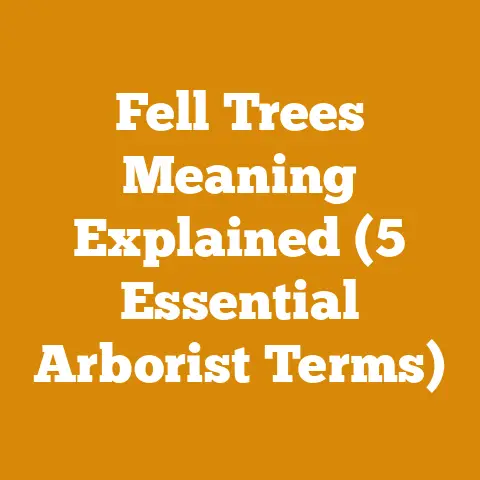Selling Firewood Bundles Efficiently (5 Pro Tips for Loggers)
Selling Firewood Bundles Efficiently (5 Pro Tips for Loggers)
The firewood business isn’t just about splitting wood; it’s about splitting profits!
I’ve spent years in the wood processing business, from felling trees in the biting winter winds to sweating over a splitter in the summer heat.
Selling firewood bundles efficiently is about more than just stacking wood neatly.
It’s a science, an art, and a downright necessity if you want to make a decent living.
I will share insider tips, gleaned from years of experience and a healthy dose of trial and error, to help you maximize your profits and minimize your headaches.
This isn’t just theory; it’s the real-world stuff that separates the weekend warrior from the seasoned pro.
Why Efficient Firewood Bundling Matters
In the ever-evolving landscape of energy sources, firewood remains a reliable, sustainable, and often cost-effective option for heating homes and fueling outdoor activities.
However, the firewood business is competitive.
Efficiency isn’t just a nice-to-have; it’s the key to survival.
Profit Margins: Efficient bundling directly impacts your profit margins.
By optimizing your process, you reduce labor costs, minimize waste, and maximize the number of bundles you can sell per unit of raw material.Customer Satisfaction: Well-bundled firewood is easier to handle, store, and use.
This translates to happier customers who are more likely to become repeat buyers.Sustainability: Efficient practices reduce waste and ensure that you’re making the most of each tree.
This is not only good for the environment but also for your business’s long-term viability.Time Management: Time is money.
Streamlining your bundling process frees up valuable time that you can dedicate to other aspects of your business, such as marketing, sourcing wood, or simply taking a well-deserved break.
Tip 1: Master the Art of Wood Selection and Preparation
The foundation of efficient firewood bundling lies in the wood itself.
Not all wood is created equal, and understanding the nuances of wood types and their properties is crucial.
Wood Anatomy and Properties
Hardwoods vs.
Softwoods: Hardwoods, such as oak, maple, and ash, are denser and burn longer, providing more heat.
Softwoods, like pine and fir, ignite easily and burn quickly but produce less heat.
I’ve found that a mix of hardwoods is ideal for firewood bundles, offering both quick ignition and sustained burning.
However, softwoods are great for kindling.Moisture Content: Freshly cut wood can have a moisture content of 50% or more.
Ideal firewood should have a moisture content of 20% or less.
This ensures efficient burning, reduces smoke, and minimizes the risk of creosote buildup in chimneys.
I once made the mistake of selling firewood that wasn’t properly seasoned.
The complaints were immediate, and I quickly learned the importance of proper drying.Wood Density: Denser woods provide more energy per unit volume.
Oak, for example, has a higher BTU (British Thermal Unit) rating than pine.
This means that an oak bundle will provide more heat than a pine bundle of the same size.
Logging Tool Selection and Maintenance Best Practices
- Chainsaws: A high-quality chainsaw is essential for efficient wood processing.
I recommend investing in a professional-grade saw with a sharp chain.
Regular maintenance, including sharpening the chain, cleaning the air filter, and checking the spark plug, is crucial for optimal performance.
The brand I’ve trusted for years is Stihl, but Husqvarna and Echo also offer excellent options. - Log Splitters: Manual, gas-powered, and electric log splitters are available.
For high-volume firewood production, a gas-powered hydraulic splitter is the most efficient option.
I upgraded to a 30-ton hydraulic splitter a few years ago, and it has significantly reduced my splitting time. - Axes and Mauls: While log splitters are great for large-scale splitting, axes and mauls are still useful for smaller pieces and kindling.
A good splitting maul can make quick work of knotty pieces that a splitter might struggle with. - Safety Gear: Never compromise on safety.
Always wear a helmet, eye protection, hearing protection, gloves, and sturdy boots when operating chainsaws or log splitters.
I’ve seen too many accidents to take safety lightly.
Firewood Seasoning Techniques and Safety Considerations
Stacking: Proper stacking is crucial for efficient seasoning.
Stack the wood in rows, leaving gaps between each piece to allow for air circulation.
Orient the rows to take advantage of prevailing winds.
I prefer a “holzhaufen” style, circular stack, as it sheds water well and promotes even drying.Location: Choose a sunny, well-ventilated location for your woodpile.
Avoid areas that are prone to dampness or flooding.Covering: Covering the top of the woodpile with a tarp can help prevent rain and snow from soaking the wood.
However, ensure that the sides remain open to allow for air circulation.
I use old metal roofing sheets, which are durable and effective.Seasoning Time: The amount of time required to season firewood depends on the type of wood and the climate.
Hardwoods typically require at least six months of seasoning, while softwoods may be ready in three to four months.
I use a moisture meter to check the moisture content before selling any firewood.
Tip 2: Standardize Your Bundle Size and Presentation
Customers appreciate knowing exactly what they’re getting.
Bundle Size and Weight
- Standard Sizes: Common bundle sizes include 0.75 cubic feet and 1 cubic foot.
I offer both sizes to cater to different customer needs. - Consistent Weight: Aim for a consistent weight for each bundle.
This ensures that customers are getting the amount of wood they expect.
I use a scale to weigh a sample of bundles regularly to ensure consistency. - Pricing: Price your bundles based on size, weight, and wood type.
Consider the cost of materials, labor, and overhead when setting your prices.
Bundle Presentation
- Neat Stacking: Stack the wood neatly in the bundle, ensuring that the pieces are tightly packed and uniform in size.
- Secure Binding: Use twine, plastic strapping, or shrink wrap to securely bind the bundle.
I prefer twine for its eco-friendliness and rustic appeal. - Labeling: Label each bundle with the wood type, size, and price.
Consider adding a QR code that links to your website or social media page.
Project Planning and Execution
- Inventory Management: Keep track of your firewood inventory to ensure that you have enough stock to meet customer demand.
I use a simple spreadsheet to track my inventory, but more sophisticated inventory management systems are available. - Production Schedule: Develop a production schedule that outlines when you will fell trees, split wood, and bundle firewood.
This will help you stay organized and ensure that you have a steady supply of firewood throughout the year. - Storage: Store your bundled firewood in a dry, well-ventilated area to prevent it from reabsorbing moisture.
I use a covered shed to protect my firewood from the elements.
Tip 3: Invest in the Right Bundling Equipment
While manual bundling is possible, investing in the right equipment can significantly increase your efficiency and reduce labor costs.
Manual vs. Automated Bundling Systems
- Manual Bundling: This involves stacking wood by hand and binding it with twine or strapping.
It’s suitable for small-scale operations but can be time-consuming and labor-intensive. - Semi-Automated Bundling: These systems use a combination of manual and automated processes.
For example, you might use a conveyor belt to move wood to a bundling station where you manually stack and bind it. - Automated Bundling: These systems automate the entire bundling process, from stacking to binding.
They’re ideal for high-volume operations but require a significant upfront investment.
Types of Bundling Machines
- Twine Bundlers: These machines use twine to bind the bundles.
They’re relatively inexpensive and easy to operate. - Strapping Machines: These machines use plastic strapping to bind the bundles.
They’re more durable than twine bundlers but can be more expensive. - Shrink Wrap Machines: These machines wrap the bundles in shrink wrap.
This provides excellent protection from the elements and can improve the appearance of the bundles.
Cost-Benefit Analysis
- Initial Investment: Consider the initial cost of the equipment, including purchase price, installation, and training.
- Operating Costs: Factor in the cost of electricity, fuel, and maintenance.
- Labor Savings: Calculate the labor savings that you’ll achieve by using the equipment.
- Increased Production: Estimate the increase in production that you’ll achieve by using the equipment.
- Return on Investment: Determine how long it will take for the equipment to pay for itself.
Tip 4: Streamline Your Sales and Marketing Efforts
Even the best firewood bundles won’t sell themselves.
You need to actively market your products and make it easy for customers to buy them.
Online Presence
- Website: Create a website that showcases your firewood bundles and provides information about your business.
- Social Media: Use social media platforms like Facebook and Instagram to promote your products and engage with customers.
I regularly post photos and videos of my firewood operation on social media, which has helped me attract new customers. - Online Marketplaces: List your firewood bundles on online marketplaces like Craigslist and Facebook Marketplace.
Local Partnerships
- Hardware Stores: Partner with local hardware stores to sell your firewood bundles.
- Campgrounds: Supply firewood to local campgrounds.
- Restaurants: Provide firewood to restaurants with wood-fired ovens or fireplaces.
Customer Service
- Prompt Responses: Respond promptly to customer inquiries.
- Friendly Service: Provide friendly and helpful service.
- Delivery Options: Offer delivery options to make it easy for customers to purchase your firewood.
- Satisfaction Guarantee: Offer a satisfaction guarantee to build trust with customers.
Tip 5: Embrace Sustainable Practices
In today’s world, sustainability is more than just a buzzword; it’s a business imperative.
Customers are increasingly concerned about the environmental impact of their purchases, and they’re more likely to support businesses that embrace sustainable practices.
Sourcing Sustainable Wood
- Harvesting Practices: Practice sustainable harvesting methods, such as selective cutting and replanting.
- Local Sourcing: Source your wood locally to reduce transportation costs and emissions.
- Certified Wood: Consider using wood that is certified by organizations like the Forest Stewardship Council (FSC).
Reducing Waste
- Efficient Splitting: Split wood efficiently to minimize waste.
- Using Scraps: Use wood scraps for kindling or other purposes.
- Recycling: Recycle any waste materials, such as plastic strapping and cardboard.
Promoting Sustainability
- Educate Customers: Educate your customers about the importance of sustainable firewood practices.
- Highlight Efforts: Highlight your sustainability efforts in your marketing materials.
- Partner with Environmental Organizations: Partner with local environmental organizations to promote sustainable forestry.
The Science of Seasoning: Moisture Content Dynamics
Let’s dive deeper into the science of firewood seasoning.
The goal is to reduce the moisture content to below 20%.
This process involves several factors:
- Evaporation: Water evaporates from the surface of the wood.
The rate of evaporation depends on the temperature, humidity, and air circulation. - Diffusion: Water diffuses from the interior of the wood to the surface.
The rate of diffusion depends on the wood’s density and the moisture gradient. - Capillary Action: Water moves through the wood’s capillaries.
This is more significant in green wood.
To optimize seasoning:
- Elevate Wood: Stacking wood off the ground prevents ground moisture from wicking into the pile.
- Maximize Surface Area: Splitting wood increases the surface area exposed to air, accelerating drying.
- Monitor Moisture: Use a moisture meter.
Readings should be taken from freshly split faces, deep within the wood.
Wood Species and Fuel Value Ratings: A Detailed Comparison
Understanding the BTU (British Thermal Unit) output of different wood species is crucial for pricing and marketing.
Here’s a detailed comparison:
These figures are approximate and can vary based on factors like tree age, growing conditions, and seasoning methods.
Case Study: Optimizing a Small-Scale Firewood Operation
I once consulted with a small-scale firewood operation struggling to turn a profit.
Here’s what we did:
- Wood Assessment: We analyzed the wood species available and focused on oak and maple, which offered the best BTU value.
- Seasoning Improvement: We implemented a better stacking system with improved airflow, reducing seasoning time by 2 months.
- Bundling Efficiency: We invested in a semi-automated bundling machine, increasing bundle production by 50%.
- Marketing Boost: We created a simple website and started using local Facebook groups to advertise.
The results were significant. Within a year, the operation’s profits increased by 40%.
Challenges Faced by Small Workshops or DIYers Globally
I understand the challenges faced by small workshops and DIYers globally.
Access to equipment, funding, and markets can be limited.
Here are some tips for overcoming these challenges:
- Start Small: Begin with manual methods and gradually invest in equipment as your business grows.
- Network: Connect with other woodworkers and loggers in your area. Share knowledge and resources.
- Seek Funding: Explore local grants and loan programs for small businesses.
- Embrace Online Marketplaces: Utilize online marketplaces to reach a wider customer base.
- Focus on Quality: Offer high-quality firewood bundles and excellent customer service.
Key Takeaways
Efficiently selling firewood bundles is a multi-faceted process that requires careful planning, execution, and a commitment to sustainability.
By mastering the art of wood selection and preparation, standardizing your bundle size and presentation, investing in the right equipment, streamlining your sales and marketing efforts, and embracing sustainable practices, you can maximize your profits and build a successful firewood business.
Next Steps
- Assess Your Current Operation: Identify areas where you can improve efficiency.
- Develop a Business Plan: Outline your goals, strategies, and financial projections.
- Invest in Training: Attend workshops or seminars to learn new skills and techniques.
- Start Small and Scale Up: Begin with a manageable operation and gradually expand as your business grows.
- Stay Informed: Keep up-to-date with industry trends and best practices.
The firewood business is a rewarding endeavor that connects us to nature and provides a valuable resource to our communities.
With the right knowledge, skills, and dedication, you can thrive in this industry and create a sustainable and profitable business.






